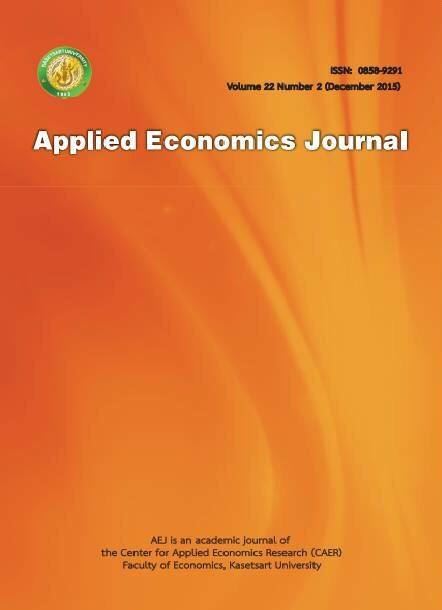Inequality and Integration economy
Main Article Content
Abstract
This issue of Applied Economics Journal (Vol.22 No.2, December 2015) emphasizes on the inequalities of Thai society, which are the root causes of various problems in the economy and society. To study problems of income inequality in Thai society, Arayah Preechametta applies the concept of social identity and income distribution so as to explain the dynamic of inequality in Thailand. The results indicate that social integration affects the decisions of median voters and may result in multiple equilibria so that the economy may end up in a suboptimal equilibrium. On the other hand, Chairat Aemkulwat focuses on the tax burden and the inequality of Thailand’s tax system. In order to understand the inequality caused by the tax system of Thailand, Chairat points out that the tax system of central government and that of local government cannot reduce inequality. Therefore, the tax collection of government should aim to promote efficiency and fairness, and also aim to increase tax revenue in order to meet with a continuous increase in government spending. A reduction in corporate tax from 30 percent to 20 percent, diminishes its significance as a major source of tax revenue. The government, therefore, should increase its revenue from other sources, especially income tax. In another article, Suthawan Prukumpai studies time-varying industrial portfolio betas under the regime-switching model for the stock exchange of Thailand. The results confirm that there is a switching in some industrial portfolios related to the major economic policy. Therefore, the performance of asset allocation and risk management strategies could be improved. It would be beneficial to both defensive and aggressive funds in adjusting their asset allocations. Applying an econometric technique and a model of aggregate demand for tourism, Akarapong Unthong analyzes the elasticity of demand for Thai tourism of ASEAN tourists. Based on the limitations and the characteristics of the data, the results indicate the importance of ASEAN tourists from both the aspect of tourist quantity and the aspect of tourism income growth. ASEAN tourists are more sensitive to Thai tourism price than competitors’ tourism prices. The results suggest that the government should use different marketing schemes according to different levels of elasticity in different countries, and focus on marketing campaigns toward high-end markets. On the aspect of impacts from outside, Sarawut Meepornsawan and Roengchai Tansuchat study the inflows of capital from other countries and the role of the quantitative easing policy of the U.S. in Thai, Brazilian and Indian economies. From a Markov-Switching Vector Autoregressive model, the results show that changes in growth rate of capital inflows in portfolio and direct investment affect the growth rate of capital market, interest rate, exchange rate, Editorial Inequality and Integration economy international trade, production, and price index in different directions in different regimes (expansion and recession). For book reviews in this issue, it is an honor to have Professor James Gerber’s interesting review of Hall of Mirrors: The Great Depression, the Great Recession and the Uses-and Misuses of History. If someone want to use history to explain today’s economic phenomenon, one has to concern that there are some limitations in doing so and one has to consider the context of current situations in the country of interest and the politics of the world in that moment as well. In another book review, Professor Roger Frantz reviews Necroeconomics: The Political Economy of Past-Communist Capitalism, which points out how to evaluate Communism and Capitalism. Frantz analyzes the concept of Papava that his views are “…especially anti-central planning at least in part because economies which were under the “thumb” of the central planning were left for “dead” at the end of the communist era. They were necro-economies…”
Article Details
How to Cite
-, .-. (2016). Inequality and Integration economy. Asian Journal of Applied Economics, 22(2), i-ii. Retrieved from https://so01.tci-thaijo.org/index.php/AEJ/article/view/57285
Section
Editorial Note
The paper is published under CC BY-NC-ND, in which the article is freely downloaded and shared in its original form non-commercially and its citation details are identified.
